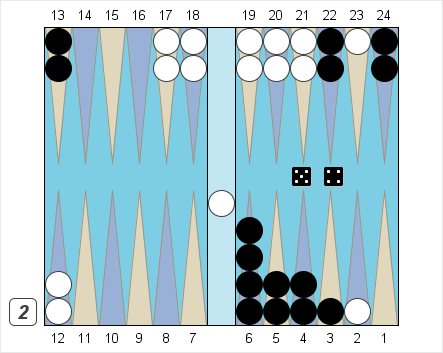
Black – Pips 163 (+27)
Black to Play 5-4
Back games are, in my view, the most interesting category of backgammon positions. Obvious plays are often wrong and counter-intuitive plays abound. Some real insight and experience are often needed to find your way to the right play.
This position is not an especially difficult problem, although most players will get it right for the wrong reason.
The classical approach to this kind of position was to play 13/8 6/2*, with the idea that if you were hit, you would fall into a strong back game, while if you were missed, you might even be able to win going forward. Thus hitting represented a “two-way” play: good winning chances no matter what course the game took.
The play is actually correct, but the reasoning is flawed. In fact, Black has virtually no chance of actually timing a back game from here, whether he gets more checkers hit or not. After Black plays his 5-4, he’ll trail by only 18 pips in the race (16 if he elects to hit). In an adequately-timed 1-3 back game, Black needs to trail by 90 pips or more. Even if Black gets hit a couple of times, he won’t have nearly enough timing to play the 1-3 game. Before White starts to break his prime, he has to move his two rear checkers all the way around the board, then bring down the checkers from the midpoint. That represents a lot of turns, probably 10 at the minimum. There’s almost no way Black’s position can hold up for that length of time.
In fact, 13/8 6/2* is just a straightforward attempt to win with a front game. Black is rooting for a fan or an entering roll like 1-4 or 1-5, after which he can make a good board pretty easily, then root for some aces, deuces, and sixes to jump White’s prime. It’s certainly something of a long shot, but much more likely than winning a busted back game. When the timing to hold a back game just isn’t there, sometimes your best chance is to attempt to win going forward. These can be hard plays to make since any chance of success seems so small. But the chance of success is small for any game plan, so just go ahead and follow your logic.





